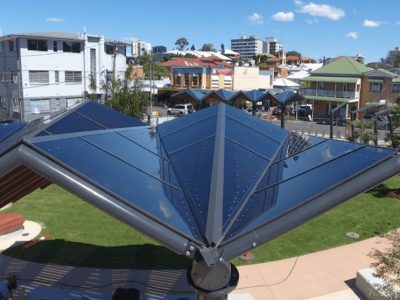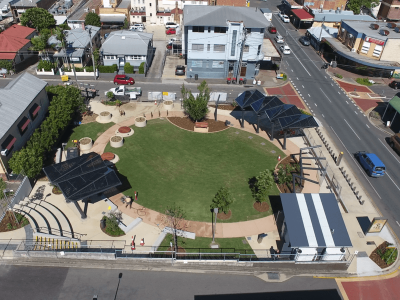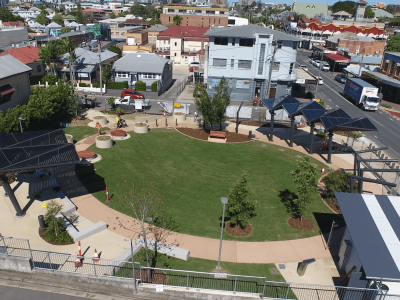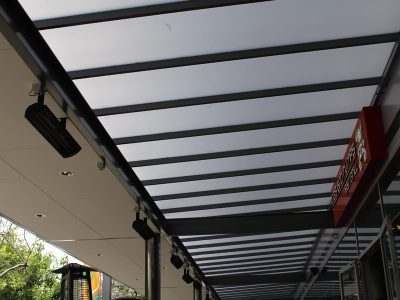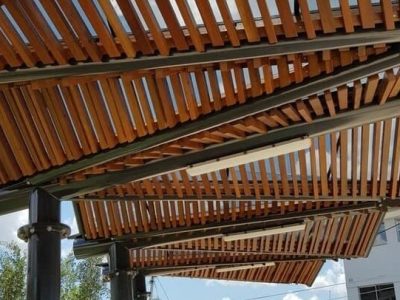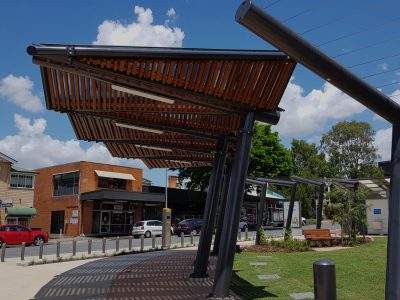
Insulated polycarbonate roofing & Sheet Brisbane
YOU ARE HERE:
Polycarbonate products are an ever-developing area, and we pride ourselves on being highly adaptable when it comes to unique design challenges that are only applicable to this type of structure. Our experience with these products includes Danpalon, Makrolon, Palram, Palsun, and EGR thermoplastics, to mention some, which allow us to be at the forefront of this field.
Our team played a key part in designing, producing and installing two custom-designed insulated polycarbonate roof panels at West End Urban Common for the Brisbane City Council.
What is Polycarbonate?
Polycarbonate is a high-impact resistant, resilient thermoplastic substrate used in roofing systems like Laserlite 2000 and Suntuf polycarbonate. It offers 99.9% protection from harmful UV rays, exceptional thermal insulation, and a huge range of options. Withstanding extreme temperatures, it provides outstanding quality of light and comes in various forms, including standing seams and roofing panels. Its versatility and durability make it an ideal choice for roofing applications, ensuring long-lasting performance and satisfaction.
Benefits of Polycarbonate
Insulated Polycarbonate roof panels are virtually unbreakable: with fifty times the impact strength of float glass and thirty times that of acrylic and even bullet proof, hence being used as police shields.
This lightweight shade solution makes it easy to transport and manage, quick and effective to install and comes with superpowers that withstand extremely high and low temperatures, making it ideal for a wide range of shade solutions including roofing, cladding, skylights, façades, and patios. No matter how complex or unique your build is, Versatile Structures polycarbonate roofing brisbane can produce a solution to bring your polycarbonate roof structure to life.
- High Light transmission properties
- High Impact strength
- UV Stabilised materials
- Light weight compared to glass or metal
- Extruded Colour options
- Thermal and light transmission control
- Waterproof architectural Structures
- Typical Lifespan up to 15 years
Recommended Applications
- Commercial construction solutions include roofing and cladding, skylights for warehouses, non-corrosive materials for seaside living, greenhouse materials, and agriculture.
- Domestic solutions include patio roofing, carports, or adding an external feature wall or wind break decks, garages, patios, sheds, and conservatories, pool covers
- Cafes, dining, and retail
- External architectural structures
- Nurseries and plant shops
- Hotels and resorts
Speciality Polycarbonate sheeting
With a large variety of polycarbonate sheets on the market, which kind is right for your project?
- FDA Approved Plastics are the only glazing and plastic material certified for sensitive applications with strict guidelines to meet. FDA polycarbonate is extremely heat resistant and offers high impact strength but are not UV stabilized.
- Fire Rated or Flame Retardant Polycarbonate, also known as low flammability (LF) polycarbonate is stronger than both glass and plexiglass sheeting and suppresses flames and the chance of fire.
- Antistatic Polycarbonate or electrostatic dissipative (ESD) polycarbonate is coated with a metal and plastic mixture that prevents static electricity from being generated. The coating does not affect the clarity of the plastic which makes it ideal for indoor and outdoor applications.
- Abrasion Resistant Polycarbonate features a coating technology that results in a significant reduction in maintenance cost and liability risk that has the impact resistance of polycarbonate, the abrasion resistance of glass and improved UV resistance. reduction of maintenance cost and liability risk. Abrasion resistant polycarbonate is ideal for schools, hospitals, and bus shelters.
- Bullet Resistant Polycarbonate protect against forced entry and does not shatter or form spider webs upon impact. It is a stronger and less expensive alternative to bullet-proof glass.
Know your product
Polycarbonate roofing Brisbane sheets are available from a range of manufacturers, but we prefer working with well-known and trusted brands like EGR Thermoplastics, Palram, Danpalon, Palsun, and Makrolon, while for insulated panel roofing, we recommend Bluescope, Stratco and Lysaght. If you are looking for a polycarbonate sheet in Brisbane, then we provide superior durability and UV protection. Polycarbonate sheets areit ideal for a variety of construction and roofing projects.
UV Protection
Untreated polycarbonate sheets Brisbane can last up to 7 years before they discolour, so it is ideal to have the sheets treated with UV protective formulas that help resist sun damage.
Treated polycarbonate sheets offer 99.9% UV protection to Australia’s harsh sun and reduces the sun’s warming effect by up to 69%. The polycarbonate sheets Brisbane also transmit light which make them ideal for high quality roof lights. Read more about polycarbonate as the ultimate UVR resistant shade structure solution
Care and Cleaning
How not to do it: Improper cleaners and cleaning techniques are the main cause of damaging polycarbonate sheets. Never use cleaning products that contain ammonia as it will tarnish the look. Also never use a dry cloth or your hand to wipe it clean as you will rub dirt into the sheet and damage or scratch it.
The best way to clean polycarbonate sheets is with Novus #1. First remove dust and dirt with water and a soft cloth or blow it off before cleaning it with Novus #1 or use warm water and dishwashing detergent instead.
Australian Made 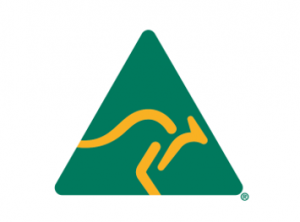
Our polycarbonate roof structures are proudly Australian made in Brisbane. We use the best materials possible to ensure durability.
Licensee ID number: 15969
Polycarbonate Sheet pricing
Polycarbonate sheets are a popular choice for a wide range of applications due to their strength, transparency, and durability. When it comes to polycarbonate sheet pricing, there are several factors to consider, including the size, thickness, and colour of the sheets, as well as the quantity being purchased. In general, thicker sheets and larger quantities tend to be more cost-effective. When it comes to colour, clear polycarbonate sheets in Brisbane are often the most affordable option, but coloured sheets, such as bronze, blue, or green, may be available at a slightly higher cost. Overall, polycarbonate sheets are a cost-effective solution for businesses and individuals looking for a strong, durable, and transparent plastic material.
Ensure reliable install
Look for reputable installers who follow excellent stringent quality control practices to ensure the best possible installation results and dependable after-sales services.
Danpalon
Danpalon is a brand of polycarbonate panels used in a variety of applications, including glazing, roofing, and wall cladding. These panels are known for their high level of transparency, energy efficiency, and resistance to UV radiation, making them an ideal choice for a wide range of projects. Danpalon panels are available in a range of colors and styles, including clear, translucent, and opal, and can be customized to meet the specific needs of each project. They are also lightweight and easy to install, making them a popular choice among architects, builders, and contractors. In addition to their practical benefits, Danpalon panels can also add a modern, sleek aesthetic to any building or structure.
Projects
Articles
Polycarbonate roof panels can typically withstand a wide range of temperatures, but their specific performance can vary depending on factors such as the type of polycarbonate used, the thickness of the panels, and the manufacturer’s specifications. In general, polycarbonate roof panels are designed to handle both high and low temperatures effectively. Here’s a general guideline for the temperature range within which polycarbonate roof panels can be used.
Always consult the manufacturer’s documentation and guidelines for the specific polycarbonate material you intend to use, as they may provide temperature tolerance information and recommendations for proper installation and maintenance. Additionally, local climate conditions and the intended application of the polycarbonate panels should be considered when assessing their suitability for a particular project.
Insulated polycarbonate roof panels can be a great choice for roofing and covering structures in Brisbane, as they offer several benefits, including thermal insulation, weather resistance, and durability. Here are some key considerations and things to know about insulated polycarbonate roof panels in Brisbane:
Insulated polycarbonate roof panels can be a valuable roofing solution in Brisbane’s climate, offering energy efficiency, UV resistance, and thermal comfort.
Polycarbonate roofing is a type of roofing material made from polycarbonate, a durable and lightweight plastic. It’s known for its strength, transparency, and resistance to UV rays, making it a popular choice for various residential applications.
Absolutely! Polycarbonate roofing is well-suited for Queensland’s climate. It’s UV-resistant, which helps protect against the harsh sun, and it’s also designed to withstand extreme weather conditions, including heavy rain and strong winds.
Polycarbonate roofing offers several benefits, including high impact resistance, excellent light transmission, UV protection, and ease of installation. It’s also lightweight and durable, making it a long-lasting and cost-effective roofing option.
Depending on the grade of polycarbonate, roofing can last up to 25 years or more with proper care and maintenance. Its durability and resistance to weathering make it a reliable choice for long-term use.
Yes, polycarbonate roofing can be energy efficient. It allows natural light to pass through, reducing the need for artificial lighting during the day. Polycarbonate comes in various technical tints designed to allow light but reduce heat. Additionally, many polycarbonate sheets come with UV protective layers that help regulate indoor temperatures, and some polycarbonate systems are multi-layered with thermal breaks providing thermal resistance values.
While it’s possible for DIY enthusiasts to install polycarbonate roofing, it’s recommended to hire a professional for the best results. Professional installation ensures the roofing is properly secured and sealed, maximizing its lifespan and performance.
Yes, polycarbonate roofing is available in a variety of colours and finishes. You can choose from clear, tinted, or opaque options to match your aesthetic preferences and functional needs. Various tints are also available to suit light and heat requirements.
Cleaning polycarbonate roofing and car park shade structures are the same and simple. Use a mild soap and water solution with a soft cloth or sponge to remove dirt and debris. Avoid using abrasive materials or harsh chemicals, as they can damage the surface. Regular cleaning helps maintain their clarity and longevity.
Polycarbonate roofing is considered environmentally friendly due to its long lifespan and recyclability. All polycarbonate is recyclable, and its ability to allow natural light can reduce energy consumption, making it a greener choice.
Polycarbonate roofing stands out for its combination of strength, light transmission, and UV protection. Compared to traditional materials like metal or tile, polycarbonate is lighter and easier to install. It’s also more impact-resistant than glass, making it a versatile and practical option for various residential and commercial applications. Similarly, waterproof shade sails offer excellent protection from the elements, combining durability and ease of installation, making them ideal for outdoor spaces in both residential and commercial setting.
Polycarbonate roofing is a lightweight, durable, thermoplastic substrate used in roofing systems such as Laserlite 2000 and Suntuf — offering up to 99.9% UV protection, excellent thermal insulation, and high light transmission. It’s known for being virtually unbreakable—50 times stronger than float glass and 30 times stronger than acrylic and even used in police shields.
This makes it especially popular in Brisbane due to its capacity to handle extreme temperatures, impact resistance, and flexibility for custom architectural designs. Its light weight also simplifies transportation and installation—ideal for patios, carports, skylights, façades, and more .
Polycarbonate offers several advantages over traditional glass or metal:
- Lightweight & Easy to Install: It’s much lighter than glass, reducing shipping and installation complexity.
- High Impact Resistance: Virtually unbreakable—far stronger than both glass and acrylic.
- Light Transmission with UV Protection: Can transmit up to 90% natural light while effectively blocking harmful UV rays—whereas glass is fragile and metal traps heat and lacks transparency
- Versatility in Design: Can be moulded in flat, curved, or multi-wall forms and is available in various colours and finishes—making it more design-friendly than glass or rigid metal.
Yes—polycarbonate roofing is well-suited for Queensland’s demanding climate:
- Excellent UV Protection: It absorbs UVR (UVA and UVB) and blocks nearly all UV radiation. Still, a thin UV-protective coating (typically one-sided) is recommended to prevent the material from yellowing and degrading.
- Durability Under Harsh Weather: Its high-impact and weather-resistant nature makes it ideal for withstand hail, strong winds, and intense sun typical of SE Queensland.
- Longer Lifespan with Treatment: With UV protection, polycarbonate can last up to 15 years, making it a durable choice for Queensland conditions.
Insulated roof panels (or sandwich panels) pair insulation cores—like expanded polystyrene (EPS), mineral wool, or PIR/polyisocyanurate—between two durable facings (often steel), delivering combined roofing, insulation, and ceiling performance.
Benefits include:
- Superior Thermal Insulation: High R-value cores help maintain stable indoor temperatures, significantly reducing heat transfer.
- Noise Reduction: They effectively dampen sounds such as rain or hail, improving acoustic comfort.
- Weatherproof & Fire-Resistant: Panels are weather-tight, waterproof, and available with non-combustible facings—ideal for fire-prone areas.
- Long Lifespan: With proper installation and maintenance, these panels can last 20+ years.
- Applications: Commonly used in commercial, industrial, and residential projects such as patios, carports, cafés, and public seating — anywhere heat control and noise reduction are important.
When combining the two—insulated polycarbonate roof panels—you get both excellent light transmission and enhanced thermal and acoustic performance, plus the same durability and weather resistance.

